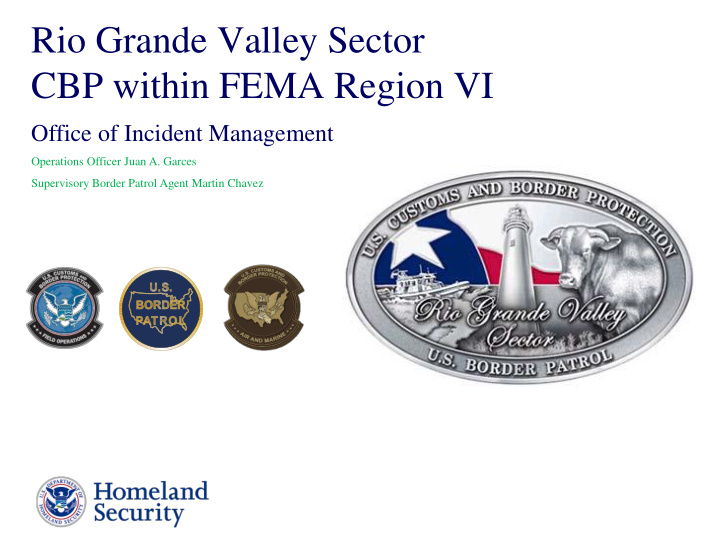



Rio Grande Valley Sector CBP within FEMA Region VI Office of Incident Management Operations Officer Juan A. Garces Supervisory Border Patrol Agent Martin Chavez Presenter’s Name June 17, 2003 1
CBP within FEMA Region VI: Mission To contribute toward the effectiveness of the Customs & Border Protection mission and preparedness efforts through the coordination of multi-component and inter/intra-agency operational activities including technical standards, contingency planning and training through exercises and readiness assessments. Presenter’s Name June 17, 2003 2
CBP within FEMA Region VI Regional Incident Management Construct • CBP components in Texas, New Mexico, Oklahoma, Arkansas, and Louisiana make up Region VI • Chief Patrol Agent Rosendo Hinojosa is currently the CBP Lead Field Coordinator (LFC) within FEMA Region VI • The LFC and the Deputy Field Coordinators have a clear area of responsibility to coordinate a CBP regional response during an emergency Presenter’s Name June 17, 2003 3
CBP within FEMA Region VI All Threats Preparedness Presenter’s Name June 17, 2003 4
Background • Master Exercise Practitioner, certified by FEMA. • Have done Emergency Management for the U.S. Border Patrol for five years (collateral duty). • Served as a Hurricane Isaac Task Force Commander for Region VI (September 2012). • Serve as a Lieutenant Colonel in the U.S. Army Reserve: Intelligence, Operations, Training, Logistics and Emergency Response (Support Civil Authorities). Presenter’s Name June 17, 2003 5
Why have exercises? • Enables entities to identify strengths and incorporate them within best practices to sustain and enhance existing capabilities. • Provide objective assessments of gaps and shortfalls within plans, policies and procedures to address areas of improvement. • Help clarify roles and responsibilities. Practice! Practice! Practice! Presenter’s Name June 17, 2003 6
Why have exercises? • Virginia Tech shooting; Apr 16, 2007, 7:15 a.m., 32 deaths. • Sandy Hook Elementary shooting; Dec 14, 2012, 9:30 a.m., 27 deaths. • Boston Marathon Bombings; Apr 15, 2013, 2:19 p.m., 3 deaths, 282 injured. • Cummings Middle School (Brownsville, TX); 1 death • Alton school bus accident (Alton, TX); 21deaths, 49 injured Presenter’s Name June 17, 2003 7
Types of Exercise (Three Types) 1. Tabletop (TTX): simulates an emergency situation in an informal, stress-free environment. • Participants are usually at the decision making level. • Gather around a table to discuss general problems and procedures of an emergency scenario. • Focus is on training and familiarization w/ roles, procedures or responsibilities. * Purpose: solve problems as a group Presenter’s Name June 17, 2003 8
Types of Exercise (Three Types) 2. Functional (FX): simulates an emergency situation in the most realistic manner possible, short of moving real people and equipment. • Interactive, designed to challenge the entire emergency management system. • Takes place in an Emergency Operations Center. • Players practice their response to an emergency by responding in a realistic manner. • Decisions and actions occur in real time (imitate reality) Presenter’s Name June 17, 2003 9
Types of Exercise (Three Types) 3. Full-Scale (FSX) : is close to the real thing as possible. It’s a lengthy exercise which takes place on location using the equipment and personnel that would be called upon in a real event. • Interactive, designed to challenge the entire emergency management system in a highly realistic and stressful environment. • Players represent all levels of personnel. • Achieves realism thru: on-scene actions/decisions, simulated victims, search & rescue, communications, equipment deployment and actual resource & personnel allocation. • Requires significant investment of time and effort and resources. Presenter’s Name June 17, 2003 10
National Incident Management System NIMS • Establishes flexible incident management protocols and procedures that all responders — federal, state, and local utilize to conduct and coordinate response actions. • Sets forth a core set of concepts, principles, terminology, and organizational processes to enable effective, efficient, and collaborative incident management at all levels of government. Presenter’s Name June 17, 2003 11
RGV Sector - Office of Incident Management Aligned to respond and support any Incident of National Significance: • Terrorism: IED Chemical Biological • Border Violence • Natural Disasters: Hurricanes Floods Tornadoes Earthquakes • Pandemics: Avian flu H1N1 • Mass Migration • Extreme Weather Conditions: Extreme Heat Winter Freeze Presenter’s Name June 17, 2003 12
Local and Federal Partnership • Lower RGV & Coastal Bend Council of Government (COG) Integration • Homeland Security Advisory Committee (HSAC) • Metropolitan Medical Response System (MMRS) – Ad Hoc Panel Member • Multi-Agency Coordination Center (MACC) – (McAllen/Weslaco) • Cameron County Local Emergency Planning Committee (LEPC) • Nueces, Cameron, Willacy, Hidalgo, Starr & Webb County Emergency Management Coordinators • Rio Grande Regional Response Association (RGRRA) • Regional Communication Interoperability System Committee Presenter’s Name June 17, 2003 13
Questions? Comments/Concerns
Operations Officer Juan A. Garces office 956-289-5621 juan.garces@dhs.gov
Recommend
More recommend